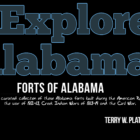Camp Shipp
Camp Shipp
Spanish American War Camp, Anniston, Alabama
Named for Lt. William E. Shipp of the 10th Cavalry who was KIA on July 1, 1898 near Santiago, Cuba. He is buried at Lincolnton, North Carolina.
The camp was established after the war on September 3, 1898 and existed through January, 1899. The 2nd Infantry was there until mid-March, 1899. There were five regiments of state volunteers there throughout much of the winter. A February 28, 1899 report published in the March 11, 1899 Army and Navy Journal stated “Camp Shipp is fast disintegrating” because of all the departures of troops.
From a photograph description of Camp Shipp in the Alabama Room collection of the Anniston Public Library: “Encampment formed at Blue Mountain after the Spanish American War. [Blue Mountain is in the north part of Anniston.] … At the end of the Spanish-American War in August, 1898, and with a final peace settlement still in the future, the U.S. Army deemed it unwise to muster out troops and needed a suitable site to quarter a large reserve force. Anniston was chosen. … Camp Shipp was located in the vicinity of Union Foundry in West Anniston.”
From Gates, The Model City of the New South, Strode Publishers, Inc., 1978, pages 140-143: “The well-drained hill just west of the American Pipe and Foundry Company was designated as the location for General Royal T. Frank’s headquarters and the first regiment. … As additional troops from the Third Tennessee and Fourteenth New York arrived, the camp spread to the hills north and east of the Hercules Pipe Company. Parades were held on the grounds of the old Anniston Inn, which was a college. … Noble Street was dotted with hastily erected tents used as restaurants for the thriving business of Camp Shipp soldiers. [Noble Street runs north and south almost through the entire city on present day maps.] … The medical facilities were the pride of the camp. In the first two months in Anniston, 636 patients were treated, with only 20 deaths reported. The hospital had been moved from Chickamauga, where an outbreak of illness was attributed to infected wells, flies, and unskilled nurses. A War Investigating Committee thoroughly inspected the hospital in October and noted considerable improvement since removal to Anniston. … By late October, several changes were made for the coming of winter. Each soldier was issued two blankets and a heavy overcoat. Every three tents were consolidated with added wooden floors and boxed sides. Wooden kitchens, mess halls, and a new division hospital were built. … Annistonians hoped that Camp Shipp would be permanent. By the end of January, however, troops began to move out. Some were discharged, some regiments were sent on to Cuba, and the 300 camp mules were ordered to Manila. … The last patient was discharged and the hospital closed in March. Even the building was removed.”
The Alabama winter was not pleasant. A February 14, 1899 report in the February 25, 1899 Army and Navy Journal indicates temperatures had reached 14 degrees below zero and that “life in tents is not what one might call comfortable.”
Source: www.usgennet.org
